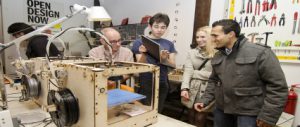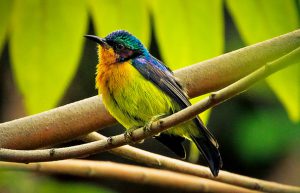From the splendour of a peacock’s feathers to the aerodynamic body of a cheetah, natural selection has worked to engineer animals to the highest standards for survival and prosperity in their environment. Throughout history, humans have tried to emulate the wonders and beauty of the natural world in science, design and art.
Over the past 20 years, however, this process of learning from and emulating nature has developed into a defined scientific discipline and burgeoning industry, known as “biomimicry”.
People have always looked to nature for inspiration. In the sixteenth century, Leonardo Da Vinci made detailed sketches of birds’ anatomy to better understand the science of flight and foster ideas for his “flying machine”. The Wright brothers, over 400 years later, were still studying birds’ wings, as a potential model for the first airplane.
Yet it was only in 1997 that the term “biomimicry” was coined, and the concept really began to take off as a serious practice in the business world.
The term “biomimicry” was first used by the American biologist and author Janine Benyus, in her book Biomimicry: Innovation Inspired by Nature. She defines biomimicry, not merely as learning “about” the natural world, but learning “from” it. Benyus calls this “the conscious emulation of life’s genius”.
Central to an understanding of biomimicry is the concept that 3.8 billion years of evolution has created a natural world full of innovative and incredible natural forms, systems and processes that are tested, sustainable and ripe for emulation. Biomimicry takes these principles from nature as inspiration to help solve human problems.
Benyus’ 1997 book was seminal in establishing the practice outside the scientific community, and in the 15 years since its publication, biomimicry has attracted a great deal of attention. Today, scientists, engineers and designers consciously study nature to understand how time-tested natural processes can help the design of innovative new products.
And major businesses are investing in the practice. In 1996, Mercedes Benz’s investments in biomimicry paid off, with a visit to the Stuttgart Museum of Natural History inspiring its engineers to design the “box fish car”, an ultra aerodynamic car based on the shape of a tropical box fish. Mercedes Benz is not alone in this investment in the study of nature.
A November 2010 report by the Fermanian Business and Economic Institute examined the growth of biomimicry in the US and predicted that by 2025 the industry could represent US$300 billion of GDP and create 1.6 million jobs.
But biomimicry experts say that the practice has more to offer than just practical design solutions. The founders of the Biomimicry Institute believe that a more widespread understanding of biomimicry as a design and innovation tool has the potential to change popular attitudes to conservation, reinforcing the importance of protecting nature’s biodiversity.
“It´s more than just a new way of viewing and valuing nature, it’s also a race to the rescue,” says Benyus.
Taking a closer look at oceans – the most biodiverse ecosystems on earth and home to 50-80% of all global lifeforms – we highlight three of the best pioneering sustainable designs that have been inspired by the ocean.
Case study one: sharkskin ships
As the Grey Whale makes its annual 12,000 mile migration from Alaska to Mexico, micro-organisms, algae, barnacles and other forms of "sea gunk" collect and build up on its skin. For the Grey Whale, and the many other marine animals this affects, it is just a harmless part of nature. However, for the millions of ships travelling through sea and ocean waters, this process known as "bio-fouling" has more serious implications.
The collation of "sea gunk" on ship hulls can increase a ship’s drag by up to 15%. This reduces the ship’s hydrodynamic efficiency, making it travel slower, consume more fuel and cause more pollution. Every year the US Navy runs up cleaning bills of US$50 million to US$1 billion just to clean their ships and reduce the impacts of bio-fouling.
To combat the environmental and financial costs of bio-fouling, biomimicry has been crucial. Tony Brennan from the University of Florida turned to nature to see which marine animals did not suffer from "bio-fouling". He discovered that regardless of the speed at which they travel through water, sharks do not pick up any forms of marine life on their skin.
Mimicking the shark’s scaly skin patterns on plastic, Brennan tested the material as a cover on ships. The invention was so successful it was adopted by the entire US Naval fleet, as well as by many commercial vessels. Given the annual global shipping trade transfers nearly 8 billion tonnes of cargo across continents, the environmental impact of this invention, with regards to the potential in emission reductions, is impressive.
The benefits of plastic "shark skin" are not limited to ships however. The material has also been used on boot soles to prevent slippage on wet surfaces, and perhaps more glamourously in the swimsuit design for Olympic athletes, to increase swimmers’ speed in the water.
Case study two: whale flipper wind turbines
Picking up a small model of a humpback whale as a holiday souvenir, Frank Fish, professor of Biology at Chester University in the United States, noticed that the flippers on the model had tiny ridges (known as tubercles) running along one side. A leading expert in biomechanics, Fish assumed these ridges were a mistaken addition. Upon investigating further, he discovered that the mistake lay not with his souvenir model but in the assumed “truths” of aerodynamic science.
Traditional aerodynamic theory taught that blades with a straight and sharp edge were the most efficient. Yet inspired by his accidental discovery, Fish decided to apply the same shape and design of the humpback whale flipper to the design of a windmill blade, and test its effects. The results were astounding. The ridged blade when applied to wind turbines led to a 20% increase in efficiency.
Further investigation is currently under way to find new applications for whale flipper-inspired design, including the possibility of adding tubercles to airplane wings or mimicking dolphin flippers in submarine design. If successful, these studies could lead to huge efficiency increases and emissions reductions in transportation.
Case study three: from coral to cement
Often called "the rainforests of the sea", coral reefs are one of the most diverse ecosystems on earth and home to a quarter of all marine life. They are also an unlikely inspiration for a clean form of modern cement-making.
As coral reefs form, coral builds its hard exoskeleton by taking in minerals and carbon dioxide and secreting calcium carbonate. The production of coral reefs can occur on a huge scale. The Great Barrier Reef, for example, is the largest biological structure on the planet, covering an area larger than the Great Wall of China.
Inspired by this ability of coral to "make more mineral than any other organism we’ve ever seen", and concerned by the high pollution associated with current methods of cement production, Brent Constantz, a professor at Stanford University began to study the natural formation of coral. He hoped to develop a way in which scientists could mimic this natural process to produce man-made cement in a more environmentally friendly way.
Constantz set up a demonstration plant in California’s Monterey Bay, in which he was able to capture and dissolve carbon dioxide in seawater to produce calcium carbonate. This calcium carbonate was successfully used to form cement.
This discovery is very good news for the environment. Not only does Constantz’s cement production method produce no carbon dioxide emissions, it actually absorbs and uses up carbon dioxide as a raw material in the process, a discovery with incredible potential for tackling rising CO2 emissions and climate change.




